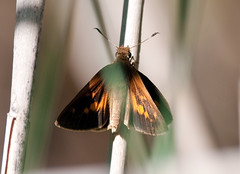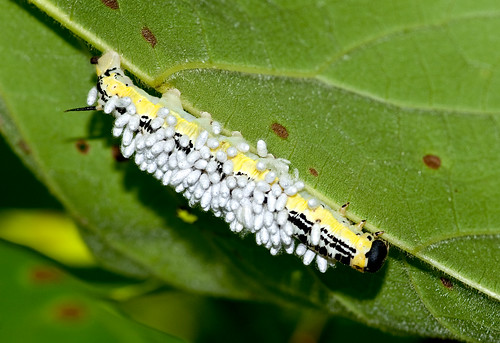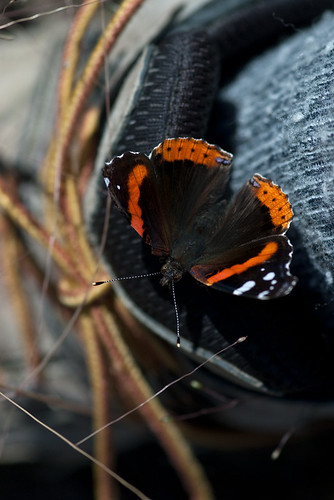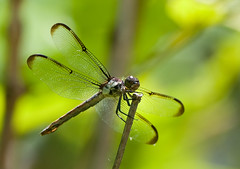Palmyra Cove – July 2, 2010
 On the first day of my 4-day ‘vacation’, I decided to take some time for myself and visit a favorite haunt, Palmyra Cove. I knew that most of the rest of the weekend would be taken up by work (both my real job and some side work I’m doing), so this might be my only chance to get out and enjoy myself. It turned out that it wasn’t particularly birdy, but there were TONS of butterflies and dragonflies around (although strangely, no damselflies).
On the first day of my 4-day ‘vacation’, I decided to take some time for myself and visit a favorite haunt, Palmyra Cove. I knew that most of the rest of the weekend would be taken up by work (both my real job and some side work I’m doing), so this might be my only chance to get out and enjoy myself. It turned out that it wasn’t particularly birdy, but there were TONS of butterflies and dragonflies around (although strangely, no damselflies).
From the start, it was obvious that the bugs were going to be the highlight of my visit. When I checked out the planting strip along the main road into the park, there were butterflies everywhere — hundreds of cabbage whites flittering between 2 large butterfly bushes and numerous other smaller flowering plants. I would estimate that each butterfly bush head 3 dozen butterflies, and one of the smaller bushes – probably no taller than 2 fee tall – was literally covered with them: probably 30-40 butterflies creating a cloud of life around the flowers.
I started at the small pond near the entrance, where several dragonflies were occupying the edges of the pond. Unfortunately, they were just a bit too far out into the muck to get any clear shots. I then started walking into the big pit, where I was greeted by a legion of different bees – dozens of large cicada killers and what seemed like thousands of smaller digger wasps buzzing around the sandy terrain looking for places to build their lairs. Strangely, despite all of these bees buzzing around, I never felt at risk from a sting – they seemed far too busy looking for each other than me. However, I did have an interesting moment when a red admiral landed on me — repeatedly, in fact — taking up position on my socks and hitching a ride for a while.
After an interesting but fairly birdless run around the pit, I started heading back toward the park proper, past the “warbler” pit which lived up to its name with several yellow warblers running around a mimosa next to the trail. Several other birds – notably catbirds – were also all over the place. In the air over the pit, I watched as a Cooper’s Hawk (which has a nest in the park) harassed a turkey vulture which must have passed too close to its nest. I’ve seen other birds mob hawks, but never seen a hawk take its turn.
As I walked along the trails in the woods, I was constantly mobbed by cabbage white and Red Admiral butterflies, with 3 more landing on me while I was in the woods (including two at once, one per leg). I’ve struggled to get any butterfly to land on me, but the vast quantities of red admirals (there must have been over 300+) must have made them more friendly. My mother-in-law had mentioned to me earlier in the day that the normally plentiful stinging nettle plants throughout the park were nearly stripped by the first brood of caterpillars born of the migratory red admirals in the spring — the evidence was all over the place; I don’t think I have ever seen the park as denuded of nettle as this. The number of admirals about was pretty good evidence, as well. Combined with the admirals were a large number of blue dasher dragonflies.
Eventually, I came to the back path that leads to the beaver pond near where I always see orioles. I wasn’t disappointed, as I saw a bunch of orchard orioles in the trees as well as a single Baltimore oriole flying across the glade. The mowed trail not only held birds along its edges but also had a ton of butterflies and dragonflies along the grassy path. In a short space, I saw wandering gliders, slaty skimmers, blue dashers, pearl crescents, common checkered skippers and several other skippers, monarchs and Eastern Comma. There were several others that I was unable to identify as they rapidly moved back and forth from the brush and flowers around the trail.
 At the beaver pond, the dragonflies were more plentiful than I have seen in years. Strangely, it seems like both butterflies and dragonflies have had abundant population increases this year, particularly over the paucity I saw last year. As I investigated the phragamites along the sure, I saw my first-of-year Widow Skimmers, as well as a single Common Green Darner hunting the pond edge. Several skippers I haven’t identified were fluttering amid the reeds, but the pond belonged to the numerous (25+) dragonflies. On my way out, I stopped to look at the catalpa trees on both sides of the path. Some looked as though they had been ravaged by locusts, while others appeared nearly untouched by the annual population of catalpa moth caterpillars; however, at first glance I couldn’t see any of the caterpillars on the trees. Eventually, however, I saw some hanging on the undersides of the leaves, staying out of the heat. And most of them were in turn being affected by a second annual visitor to the park and a scourge to the caterpillars – braconid wasps who lay their eggs on the caterpillars in great numbers. Nearly every caterpillar I saw had a significant number of parasitic wasp eggs, although a few were ‘clean’.
At the beaver pond, the dragonflies were more plentiful than I have seen in years. Strangely, it seems like both butterflies and dragonflies have had abundant population increases this year, particularly over the paucity I saw last year. As I investigated the phragamites along the sure, I saw my first-of-year Widow Skimmers, as well as a single Common Green Darner hunting the pond edge. Several skippers I haven’t identified were fluttering amid the reeds, but the pond belonged to the numerous (25+) dragonflies. On my way out, I stopped to look at the catalpa trees on both sides of the path. Some looked as though they had been ravaged by locusts, while others appeared nearly untouched by the annual population of catalpa moth caterpillars; however, at first glance I couldn’t see any of the caterpillars on the trees. Eventually, however, I saw some hanging on the undersides of the leaves, staying out of the heat. And most of them were in turn being affected by a second annual visitor to the park and a scourge to the caterpillars – braconid wasps who lay their eggs on the caterpillars in great numbers. Nearly every caterpillar I saw had a significant number of parasitic wasp eggs, although a few were ‘clean’.
Alas, it was getting toward noon and I needed to start heading out. But the park wasn’t ready to stop offering interesting tidbits here and there. An Eastern Towhee challenged me when I dared reply to his call, and an Indigo Bunting surprised me with a visit. As I was walking down the path toward the entrance, another pair of red admirals landed on me – one of my leg and another on my shoulder. The last one hung on for a while with me as I walked down, finally taking off as I approached my car.
Overall, it was a short visit — about 3.5 hours — but it was a good trip and a nice hike.
Bird List
- Baltimore Oriole
- Orchard Oriole
- Yellow Warbler^
- Common Yellowthroat
- Cooper’s Hawk
- House Wren
- Blue-gray Gnatcatcher
- Mockingbird
- Eastern Kingbird
- Chickadee
- Tufted Titmouse
- Eastern Towhee
- Canada Goose
- Barn Swallow
- Indigo Bunting
- Cardinal
- Song Sparrow
- Red-winged Blackbird
- Turkey Vulture
- Cowbird
- Rock Pigeon
- American Robin
- Starling
Butterflies
- Cabbage White (1000s)
- Red Admiral (300+)
- Eastern Comma
- Eastern Tiger Swallowtail
- Black Swallowtail
- Spicebush Swallowtail
- Common Buckeye
- Monarch
- Least Skipper^
- Silver-spotted Skipper
- Common Checkered Skipper^
- Sachem
- 3 other skipper spp.
- Catalpa Moth Caterpillars^
Dragonflies
- Great Blue Skimmer^
- Eastern Pondhawk
- Common Green Darner
- Blue Dasher (100+)
- Slaty Skimmer
- Widow Skimmer^
- Common Whitetail (100+)
- Swamp Darner
- Black Saddlebags
- Wandering Glider^

